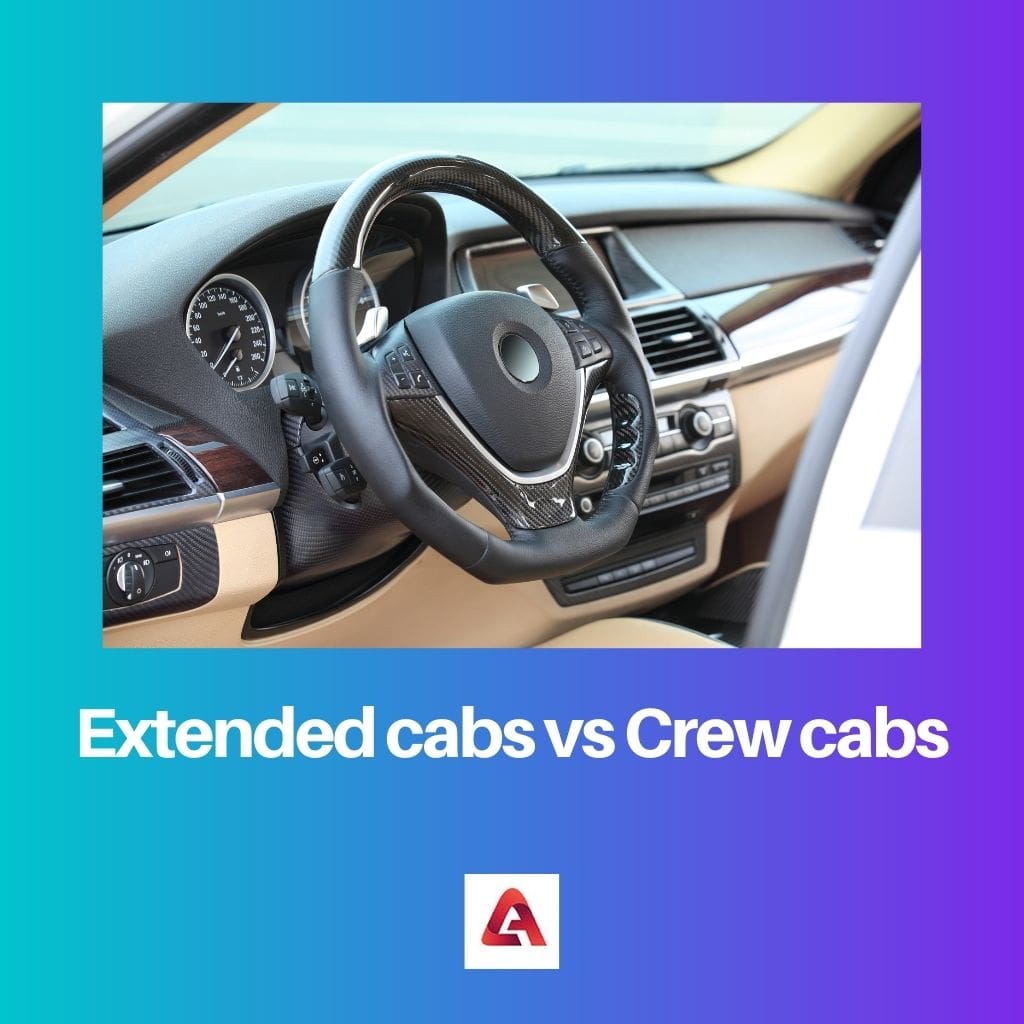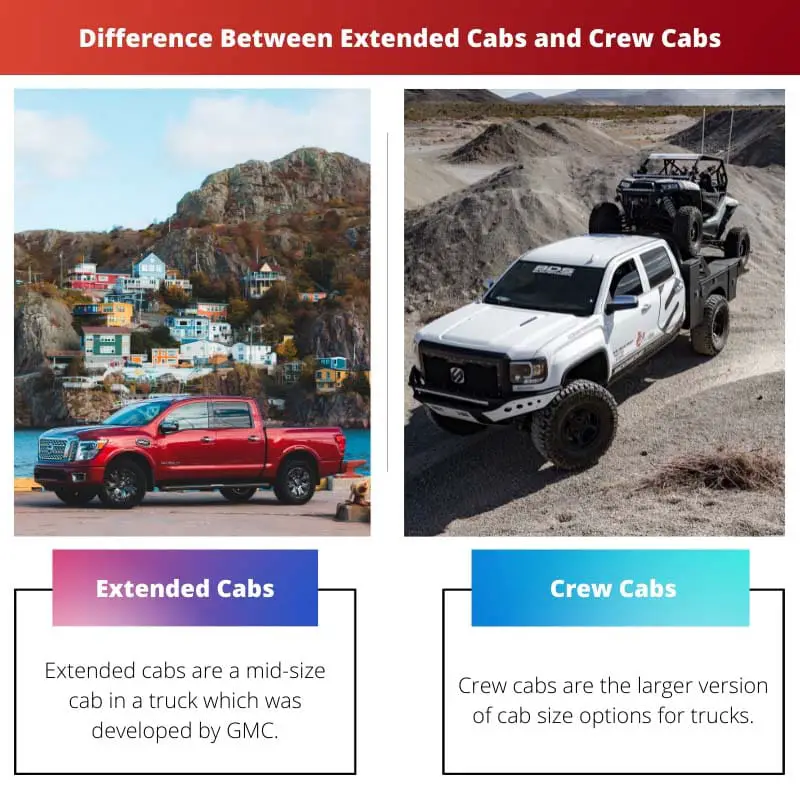With the increasing popularity of trucks for daily drivers, truck manufacturing companies have presented individuals with various cab designs. As proportions change with time, it can be overpowering for an individual to choose the right size cab that best suits his requirements.
Amongst the many options an individual can choose from, the two most efficient choices are Extended Cabs and Crew Cabs. Extended and crew cabs are large-size truck cabs that were initiated once cabs became famous in metropolitan cities.
However, since it is pretty easy for individuals to confuse themselves over the two different models of truck cabs, they must brush up on their knowledge of cabs and their classifications to purchase the best out of the lot.
Key Takeaways
- Extended cabs are truck cabins with a smaller rear seating area featuring rear-hinged doors or smaller front-hinged doors for accessing the rear seats.
- Crew cabs are truck cabins with a larger rear seating area, providing more space and comfort for passengers and featuring full-sized, front-hinged rear doors.
- The choice between extended and crew cabs depends on individual needs for passenger space, comfort, and cargo capacity.
Extended Cabs vs Crew Cabs
An extended cab is a regular cab with extra room having two rows of seats with three seats in each row, but the seats are not easily accessible since they may or may not have back doors. A crew cab is a truck with four doors and two rows of seating. They are larger than extended cabs.

Comparison Table
| Parameters of comparison | Extended cabs | Crew cabs |
|---|---|---|
| Size | Extended cabs are mid-size cabs. | Crew cabs are the larger size cabs. |
| Doors | Extended cabs have no full-sized doors, rear doors, and half-sized doors. | Crew cabs have full-sized doors. |
| Bed options | Extended cabs have the longest option of beds. | Crew cabs do not have the most extended option of beds. |
| Cost | Extended cabs are cheaper than crew cabs. | Crew cabs are slightly more expensive when compared to extended cabs. |
| Interior | The interior of the extended cabs is comparatively more minor. | The interior of the crew cabs is more extensive. |
What are Extended Cabs?
Extended cabs are mid-size cabs in a truck developed by GMC and Chevy and have the same configuration as super cabs. They are similar to regular cabs but have extra rows at the back of the truck.
These rear seats come in various forms, such as foldable seating and stationary beach seats, also called jump seats. Extended cabs are smaller than crew cabs.
The rear seats of the extended cabs are smaller than the back seats of the crew cabs. The rear seats of the truck can also carry things.
Extended cabs have four doors that can open either from the truck’s interior or exterior. Rear-hinged doors can be opened only when the vehicle’s front doors are opened.
This kind of design for the extended cabs allows access to the rear seats for passenger entry. Some of the older models of extended cabs have only three doors.
Additionally, some models have a two-door design that requires passengers who want to be seated at the back to crawl in through the door at the front of the truck. The rear door windows of the extended truck cabs do not roll down.
Extended cabs can hold up to six people and are ideal for people who use their trucks for work. Some examples of extended cabs are the 2012 Ford F-150 FX4, 2019 Ram 1500 Laramie, etc.
What are Crew Cabs?
Crew cabs are the larger version of cab size options for trucks. Unlike regular cabs, primarily designed for work, crew cabs are designed for transporting passengers or families.
Crew cabs have a row of seats at the back, like extended cabs but larger. Companies like Chevy, GMC, Dodge, and Nissan use the term ‘crew cabs’ to describe a truck with four full-sized doors.
Crew cabs are mainly used for seating approximately four to six passengers. If crew cabs hold around six people, the seating may be tight.
Crew cabs with front and back seats can hold up to a limit of five people. While many crew cab manufacturers have one seating design, many others offer seat selection as an option.
Although various manufacturing companies have variations in configuration, dimensions, and accessories, crew cabs offer more seating space for the passengers at the front and at the rear compared to extended cabs. Crew cabs additionally have feature of rear windows that are full-size and can roll up and down.
In general, Crew cabs are considered to be more expensive than extended cabs. Some examples of crew cabs are the 2018 Nissan Frontier, 2021 GMC Crayon, etc.
Main Differences Between Extended Cabs and Crew Cabs
- Extended cabs are the middle alternative of cab size as they are more significant than regular cabs and smaller than crew cabs. Crew cabs are the more prominent alternative to cab sizes as they are more influential than extended and regular cabs.
- Extended cabs may or may not have back doors. For the passengers to go to the back seat, and can access the back row by folding the chairs at the front. Most of the extended cabs do not have back doors or full-sized doors. Crew cabs have both full-sized front and rear doors. Some crew cabs have gates at the back that open either backward or opposite the front doors.
- Extended cabs have beds of varying lengths and sizes, but a longer bed is considered more practical on extended cabs. Crew cabs, the longest cabs, may not have a long bed as it would make it hard to drive. Keeping this factor in mind, crew cabs have small beds.
- Extended cabs are cheaper as they are economical and do not have as many features as crew cabs. Crew cabs are costly since they have full-sized doors and are more extensive.
- Extended crews are considered to have a smaller interior when compared to crew cabs. Crew cabs have a larger interior space when compared to extended cabs.


It’s easy to see why confusion might arise between these two similar yet different models of truck cabs. Excellent breakdown of the key differences, the choice indeed depends on individual needs.
I agree. Understanding the differences is crucial to selecting the right truck.
Definitely, choosing between extended and crew cabs depends on specific needs for passenger space, comfort, and cargo capacity.
A compelling comparison between extended and crew cabs. It’s a crucial guide for potential truck buyers to make an informed decision.
Absolutely, knowing the differences is key to making the right choice when purchasing a truck.
The comparison table highlighting the differences between extended and crew cabs is very helpful. It makes it easier to understand and decide based on specific needs.
Absolutely, the clarity in the differences helps significantly in making an informed decision.
The increasing popularity of trucks for daily drivers has indeed presented individuals with various cab designs to choose from. It’s essential to know the differences between extended and crew cabs to purchase the best one that suits your requirements.
Agreed, with the plethora of options available, it’s easy to get confused. But knowing the key differences is crucial to make an informed decision.
The comparison between extended and crew cabs gives a detailed understanding of the features and differences. It’s quite helpful for potential truck buyers.
I couldn’t agree more. It provides practical insights for potential truck buyers.
Indeed, the detailed comparison is quite informative.
It’s fascinating to know the detailed differences between extended cabs and crew cabs. The insight into the interiors of both is quite informative.
I couldn’t agree more. The detailed insight into the interior differences makes it easier to understand the practical aspects.
The detailed breakdown of the differences is very helpful to understand the specific advantages of each cab. Very informative.
Indeed, the comparison provides valuable insights into these two popular truck cab options.
Absolutely, understanding these differences is essential to guide the decision-making process.
I think the most efficient choices such as Extended Cabs and Crew Cabs should be always the priority when getting a truck. Great comparison of these two options.
Absolutely, both options have their advantages. But knowing the individual needs is crucial to make the right decision.
I couldn’t agree more. The comparative analysis presented is very informative.
The comparison between extended and crew cabs is quite comprehensive, and it provides a clear understanding of the differences between the two. Great insights!
Absolutely, the post presents a substantial amount of valuable information.
Agreed, the detailed comparison helps in making an informed decision when purchasing a truck.
I appreciate the detailed comparison between extended and crew cabs. Great insights!